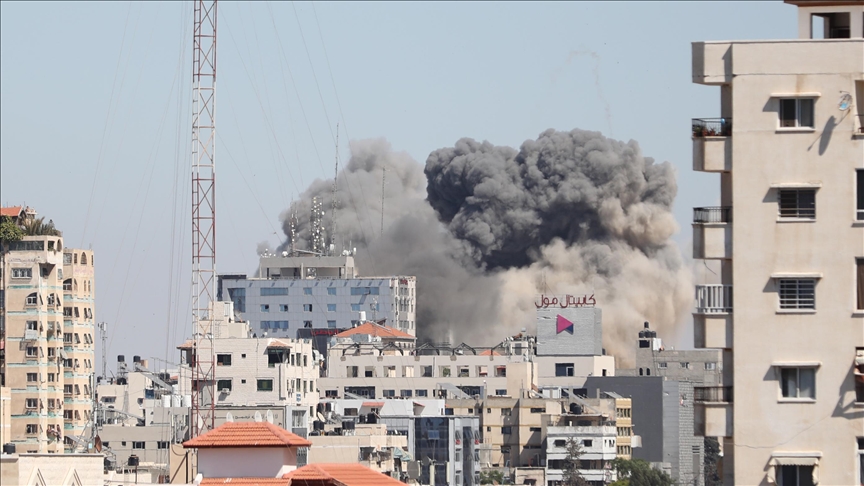Youmna al-Sayed had less than an hour to get to safety.
But with just one elevator working in al-Jalaa tower, an 11-storey building in Gaza City housing some 60 residential apartments and a number of offices, including those of Al Jazeera Media Network and The Associated Press, al-Sayed made a dash for the stairs.
“We left the elevator for the elderly and for the children to evacuate,” the Palestinian freelance journalist said. “And we were all running down the stairs and whoever could help children took them down,” she added. “I myself helped two children of the residents there and I took them downstairs – everyone was just running quickly.”
Moments earlier, the Israeli army, which has been bombarding Gaza for six straight days, had given a telephone warning that residents had just an hour to evacuate the building before its fighter jets attacked it.
Al Jazeera’s Safwat al-Kahlout also had to move quickly. He and his colleagues “started to collect as much as they could, from the personal and equipment of the office – especially the cameras”, al-Kahlout said.
But more time was needed.
“Just give me 15 minutes,” an AP journalist pleaded over the phone with an Israeli intelligence officer. “We have a lot of equipment, including the cameras, other things,” he added from outside the building. “I can bring all of it out.”
Jawad Mahdi, the building’s owner, also tried to buy more time.
“All I’m asking is to let four people … to go inside and get their cameras,” he told the officer. “We respect your wishes, we will not do it if you don’t allow it, but give us 10 minutes.”
“There will be no 10 minutes,” the officer replied. “No one is allowed to enter the building, we already gave you an hour to evacuate.”
When the request was rejected, Mahdi said: “You have destroyed our life’s work, memories, life. I will hang up, do what you want. There is a God.”
The Israeli army claimed there were “military interests of the Hamas intelligence” in the building, a standard line used after bombing buildings in Gaza, and it accused the group running the territory of using journalists as human shields. However, it provided no evidence to back up its claims.
“I have been working in this office for more than 10 years and I have never seen anything [suspicious],” al-Kahlout said.
“I even asked my colleagues if they’ve seen anything suspicious and they all confirmed to me that they have never seen any military aspects or the fighters even coming in and out,” he added.
“In our building, we have lots of families that we know for more than 10 years, we meet each other every day on our way in and out to the office.”
Gary Pruitt, president and CEO of AP, also told Al Jazeera: “I can tell you that we’ve been in that building for about 15 years for our bureau. We certainly had no sense that Hamas was there.”
Al-Sayed, who has been covering Israel’s bombardment for Al Jazeera and has worked for AP, said she could not understand what threat a building housing families and offices for lawyers, doctors and media workers could pose.
“Where is the alarm from this? Where are the Hamas or any military members that could be in this building?” the Gaza resident asked.
“The people here, the residents, all know each other. The first five floors are for offices that are [closed] during this time of escalation. So basically what is [still here] are the two media offices of Al Jazeera and AP and the residential apartments.”
Still, at 3:12pm (12:12 GMT), the first Israeli strike came. Five minutes later, al-Jalaa tower crashed to the ground after being hit by three missiles that sent a dark cloud of dust and debris into the air. There have been no immediate reports of casualties.
“Years of memories, years of work in this building, suddenly, everything is rubble,” said al-Kahlout, about the tower from whose roof he often broadcast from. “Just vanished.”
Source: Aljazeera




